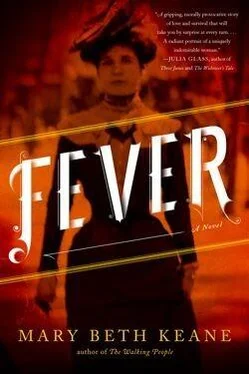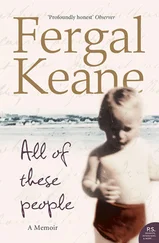After a while, she laid him in his crib and went to tell Mr. Kirkenbauer, the only other member of the household who was not sick. “He’s gone, sir,” she said, and put her hand on his shoulder before she realized what she’d done. The doctor said Mrs. Kirkenbauer should not be told if she was to have any chance of recovery, and so Mary tried to keep the news from her face when she went in to nurse her. But, one week later, Mrs. Kirkenbauer died as silently as her son, and the butler the day after that. The nanny and the gardener recovered.
• • •
Two weeks after the boy’s death, after seeing to his little funeral suit, Mary packed her things and walked to the train station, leaving Mr. Kirkenbauer alone to decide what to do about all those dresses, that big, infected house, all those toy boats, the wooden horses, the collection of little shoes and caps. Maybe it was the timber, people said. Where had it been shipped from? Maybe it was the slope of the land and the way the water ran off down to the river. Maybe it was the pipe leading from the indoor privy. Maybe it was all the pickled herring and pigs’ knuckles Mrs. Kirkenbauer asked her cook to buy in town. Maybe the mistress didn’t know how to run a house, being the daughter of a Philadelphia grocer and the granddaughter of a cabbage-shaver. How lucky for her, the neighbors said, to have caught the eye of Alexander Kirkenbauer. How unlucky for him.
People said the old country was full of death, Mary’s old country and everyone else’s. The American papers would have a person believe Europe was one large sick ward, the people dying in ditches, blown over by every stiff wind. Alfred’s Germany was like her Ireland, from the sound of it: people fighting every minute to stay on the side of the living, killing one another over a bowl of rabbit stew, and praying every day that the roofs of their shelters would stay where they were. When babies were born everyone willed them to live, but there was no surprise when they died, eventually, almost all of them, including the two Mary had cared for herself, bringing them eight, nine, ten times a day to the teat of a neighbor’s goat so they could suckle what Mary’s sister couldn’t offer, having died bringing them to life, and what Mary couldn’t offer, being only fourteen at the time, and having no babies of her own. The goat let them suck, but they died anyway, first the boy, and then the girl, and that’s when Mary’s nana told her it was time for her to leave Ireland, to leave while she was able. In America, Nana said, people didn’t die so easily. It was the air, she supposed. The meat.
But people died in America, too, Mary learned quickly. It was just a sneakier death, a crueler death, in a way, because it always seemed to come by surprise. She didn’t notice at first, but then she began to see it all around her. A meal pushed away for lack of appetite. A nap in the afternoon. A tired feeling that turned into a head cold, a rash into a ring of fire, a head cold into a fever that ravaged the person, left him beyond the reach of help. If they didn’t die of illness, they died in fires, they were run over by streetcars, drowned in the river, suffocated after slipping into a coal hill and unable to scramble back to the surface. Neighbors, strangers on the street, peddlers at the market, children, priests, landlords, ladies. They all died, and every death was brutal. So what’s a body to do? Mary thought as she stared out the train window at the Hudson and counted the minutes until she’d see Alfred again.
But that warm, clever little boy this time. The more she instructed herself to think about other things, the more she thought of him, like lifting a black tarp to glimpse something horrible below. Glimpses were all she could manage. His face. That peculiar, angled light in the Kirkenbauer kitchen. The dead weight of him.
Recently, when she and Alfred were talking about marriage and managing to not raise their voices, he’d asked whether she wanted a child. If she wanted to have a child, then that was different. Then they’d have to be married for the child’s sake. “But I thought you didn’t want that,” Alfred pointed out, and she realized it was probably something she’d said. Not because she didn’t think she’d love a child, or because she didn’t think she’d be a good mother. She knew she’d love their child fiercely, entirely. She’d think about him or her every minute of her life, and that was the danger. They were so fragile, and it was so long until they grew strong. She thought of her sister’s babies curled against each other in their cradle, and then the girl alone, how at only eight days old she seemed to be searching for her brother, her newborn fists closed so tight Mary believed for a day she might live. She thought of Mr. Kirkenbauer, the day he picked her up from the train, how he had no idea what was coming.
I’m sorry I left, she’d say to Alfred, who would be surprised to see her home so soon. But she wouldn’t tell him what had happened, because how could she possibly explain to anyone about that boy, that baby? How could she begin? Thinking about him for a single second — the strong grip of his small hand, his belly, the happy swing of his leg on the chair when he bit into a piece of orange — any thought of him at all brought a roaring into her ears like she’d been plunged into the ocean with a weight tied around her foot.
No, she decided. No. She’d go home and try to forget and do as she’d always done, which was work hard and be thankful every day for her good health, her life.
NEW-YORK DAILY COURANT
March 24, 1907
Cook Accused of Giving Typhoid to New York’s Prominent Families
_______________
So Say Authorities Holding Her Prisoner
_______________
Sanitary Engineer Alleges She Communicates the Disease to Others Although Immune Herself
(Staff) New York — The cook for a prominent Upper East Side family has been forcibly removed from her employment and quarantined in Willard Parker Hospital after sanitary engineer and medical investigator George A. Soper alleged that she has been passing Typhoid Fever through her cooking, though she manifests no signs of the disease herself. At the time of her capture she was cooking for one of the wealthiest families on Park Avenue. Dr. Soper further alleges that the daughter of the family was battling Typhoid Fever at the time the cook was apprehended, and has since succumbed to the disease.
Dr. Soper, the medical sleuth at the center of this case, put the pieces of this groundbreaking puzzle together after being called upon to investigate a Typhoid outbreak that occurred in Oyster Bay last summer. He identified the cook as an “asymptomatic carrier” of Typhoid Fever, which, in layman’s terms, is a healthy-seeming person who passes a disease along without suffering any symptoms of said disease, and most likely without any knowledge of doing so. Dr. Soper has spent several months making his case to the Department of Health, and one source reports that there are many within that organization who are skeptical about the notion of a healthy carrier, despite the evidence.
It is Dr. Soper’s belief that the woman poses a life-threatening risk to all of those who eat the food she cooks, and has been the cause of Typhoid outbreaks in almost every prominent family she’s worked for going back at least five years, likely longer. The case of this human culture tube, as some would describe her, is attended to with more secrecy than any other this reporter has encountered in his career. It can only be assumed that authorities do not want to further embarrass those families who hired her and welcomed her into their homes. In response to a question on how rare this woman is to science, one doctor who asked to remain anonymous answered: “We just don’t know.”
Читать дальше












